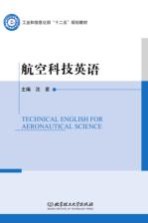

航空科技英语PDF电子书下载
- 电子书积分:10 积分如何计算积分?
- 作 者:沈星主编;孙志军副主编
- 出 版 社:北京:北京理工大学出版社
- 出版年份:2015
- ISBN:9787568206082
- 页数:224 页
Chapter 1 Introduction 1
1.1 History of Aviation 1
1.2 Basic Aerodynamics 3
1.2.1 Theories in the Production of Lift 3
1.2.2 Bernoulli’s Principle of Differential Pressure 4
1.3 Basic Engineering Design Process 5
1.3.1 Identification of the Need 5
1.3.2 Definition of Problems 6
1.3.3 Design Constraint 6
1.3.4 Synthesis, Analysis and Optimization 6
1.3.5 Mathematical Modeling and Evaluation 6
1.3.6 The Presentation 7
1.4 Aircraft Type and Category 7
1.4.1 Ultralight Vehicles 7
1.4.2 Light Sport Aircraft (LSA) Category 8
Words and Expressions 8
Translations 10
第一章 简介 10
1.1航空历史 10
1.2空气动力学基础 13
1.2.1升力产生原理 13
1.2.2压力差的伯努利原理 13
1.3基本工程设计过程 14
1.3.1鉴定需要 14
1.3.2问题定义 14
1.3.3设计约束 14
1.3.4合成、分析与优化 15
1.3.5数学建模和评估 15
1.3.6演示 16
1.4飞机类型和类别 16
1.4.1 超轻型交通工具 16
1.4.2 轻型运动飞行器的类别 17
Chapter 2 Aircraft Structure 18
2.1 Types of Aircraft Construction 18
2.1.1 Truss Structure 18
2.1.2 Monocoque 19
2.1.3 Semimonocoque 19
2.2 Major Components 20
2.2.1 Fuselage 20
2.2.2 Wings 20
2.2.3 Empennage 21
2.2.4 Landing Gear 21
2.2.5 Powerplants 22
2.3 Aircraft Structure Materials 23
2.3.1 Structure Materials 23
2.3.2 Criteria for the Selection of Materials 24
2.3.3 Application of Materials 24
Words and Expressions 26
Translations 30
第二章 飞机结构 30
2.1飞机结构类型 31
2.1.1桁架结构 31
2.1.2硬壳式 31
2.1.3半硬壳式 31
2.2主要组成部分 32
2.2.1机身 32
2.2.2机翼 32
2.2.3尾翼 32
2.2.4起落架 33
2.2.5发动机 33
2.3飞机结构材料 34
2.3.1结构材料 35
2.3.2材料选择的指标 35
2.3.3材料应用 36
Chapter 3 Theory of Flight 38
3.1 Structure of the Atmosphere 38
3.1.1 Atmospheric Pressure 38
3.1.2 Pressure Altitude 40
3.1.3 Density Altitude 40
3.1.4 Effects of Pressure on Density 42
3.1.5 Effects of Temperature on Density 42
3.1.6 Effects of Humidity (Moisture) on Density 43
3.2 Theories in the Production of Lift 43
3.2.1 Newton’s Basic Laws of Motion 43
3.2.2 Magnus Effect 44
3.2.3 Bernoulli’s Principle of Differential Pressure 46
3.3 Airfoil Design 47
3.3.1 Low Pressure Above 48
3.3.2 High Pressure Below 48
3.3.3 Pressure Distribution 49
Translations 50
第三章 飞行理论 50
3.1大气组成 50
3.1.1大气压力 50
3.1.2压力高度 52
3.1.3密度高度 52
3.1.4压力对密度的影响 53
3.1.5 温度对密度的影响 53
3.1.6 湿度(潮湿)对密度的影响 53
3.2升力产生的原理 54
3.2.1牛顿基本运动定律 54
3.2.2马格努斯效应 55
3.2.3压力差的伯努利原理 57
3.3机翼设计 57
3.3.1低压在上 58
3.3.2高压在下 59
3.3.3机翼的压力分布 59
Chapter 4 Principles of Flight and Flight Control 60
4.1 Principles of Flight 60
4.2 Aircraft Axes and Stability 63
4.2.1 Axes 63
4.2.2 Stability 64
4.3 Flight Control 65
4.3.1 Primary Flight Control 65
4.3.2 Secondary Flight Control 68
Translations 70
第四章 飞行原理和飞机控制 70
4.1飞行原理 70
4.2飞机轴向和稳定性 73
4.2.1轴 73
4.2.2稳定性 74
4.3飞行控制 75
4.3.1主要飞行控制 75
4.3.2辅助飞行控制 77
Chapter 5 Aircraft Systems 79
5.1 Powerplants 79
5.1.1 Reciprocating Engines 79
5.1.2 Propellers 81
5.2 Induction Systems 85
5.3 Fuel Systems 86
5.3.1 Fuel-pump Systems 86
5.3.2 Fuel Primers 87
5.3.3 Fuel Tanks 87
5.3.4 Fuel Gauges 87
5.3.5 Fuel Selectors 87
5.3.6 Fuel Strainers, Sumps, and Drains 88
5.3.7 Fuel Grades 88
5.3.8 Fuel Contamination 89
5.3.9 Refueling Procedures 90
5.4 Starting Systems 90
5.5 Oil Systems 91
5.6 Engine Cooling Systems 93
5.7 Exhaust Systems 94
5.8 Electrical Systems 95
5.9 Hydraulic Systems 98
5.9.1 Landing Gear 99
5.9.2 Tricycle Landing Gear Airplanes 100
5.9.3 Tailwheel Landing Gear Airplanes 100
5.9.4 Fixed and Retractable Landing Gear 101
5.9.5 Brakes 101
5.10 Oxygen Systems 102
5.11 Anti-ice Systems 103
5.11.1 Airfoil Anti-ice and Deice 103
5.11.2 Windscreen Anti-ice 104
5.11.3 Propeller Anti-ice 105
5.11.4 Other Anti-ice and Deice Systems 105
Words and Expressions 105
Translations 118
第五章 飞机系统 118
5.1动力装置 118
5.1.1往复式发动机 118
5.1.2螺旋桨 119
5.2进气系统 123
5.3燃油系统 124
5.3.1油泵系统 124
5.3.2启动注油器 124
5.3.3油箱 125
5.3.4燃油表 125
5.3.5燃油选择器 125
5.3.6燃油过滤器/油底壳/排油管 125
5.3.7燃油等级 126
5.3.8燃油污染 126
5.3.9加油程序 127
5.4启动系统 127
5.5润滑系统 128
5.6制冷系统 130
5.7排气系统 131
5.8电力系统 131
5.9液压系统 134
5.9.1起落架 135
5.9.2前三点式起落架飞机 135
5.9.3后三点式起落架飞机 136
5.9.4固定式和伸缩式起落架 136
5.9.5制动器 137
5.10供氧系统 137
5.11防冰装置 138
5.11.1机翼防冰和除冰 138
5.11.2挡风玻璃防冰 139
5.11.3螺旋桨防冰 139
5.11.4其他防冰和除冰系统 140
Chapter 6 Flight Instruments 141
6.1 Pitot-static Flight Instruments 141
6.1.1 Impact Pressure Chambers and Lines 142
6.1.2 Static Pressure Chambers and Lines 142
6.1.3 Altimeters 142
6.1.4 Vertical Speed Indicators (VSIs) 146
6.1.5 Airspeed Indicators (ASIs) 148
6.2 Gyroscopic Flight Instruments 150
6.2.1 Gyroscopic Principles 150
6.2.2 Turn Indicators 152
6.2.3 Attitude Indicators 154
6.2.4 Heading Indicators 156
Translations 156
第六章 飞行仪表 156
6.1皮托静压飞行仪表 156
6.1.1冲压腔和管子 157
6.1.2静压腔和管子 157
6.1.3高度计 158
6.1.4垂直速度指示器 161
6.1.5空速指示器 161
6.2陀螺飞行仪表 164
6.2.1陀螺原理 164
6.2.2转弯指示仪 166
6.2.3姿态指示仪 167
6.2.4航向指示仪 169
Chapter 7 Aircraft Performance 170
7.1 Performance 170
7.1.1 Straight-and-level Flight 171
7.1.2 Climb Performance 172
7.1.3 Range Performance 174
7.1.4 Runway Surface and Gradient 177
7.1.5 Takeoff and Landing Performance 179
7.1.6 Performance Speeds 184
7.2 Major Differences in Transport Category Versus Non-transport Category Performance Requirements 185
7.2.1 Performance Requirements 186
7.2.2 Takeoff Planning 186
7.2.3 Runway Requirements 187
Translations 188
第七章 飞行性能 188
7.1性能 189
7.1.1平直飞行 189
7.1.2爬升性能 190
7.1.3航程性能 192
7.1.4跑道表面和坡度 195
7.1.5起飞和着陆性能 196
7.1.6性能速度 200
7.2运输类与非运输类飞机性能要求的主要差别 201
7.2.1性能要求 201
7.2.2起飞计划 202
7.2.3跑道要求 202
Aviation Abbreviation 204
- 《科技语篇翻译教程》雷晓峰,李静主编 2020
- 《上海市订购外国和港台科技期刊联合目录 1983 上》上海科学技术情报研究所 1983
- 《生物科技、医学与法律》齐延平,安·玛丽·杜盖著 2018
- 《科技新闻英语 英汉互译精选》郑佩芸主编;吴越,郭亮,毛隽副主编 2019
- 《科技法教程》李功国著 1993
- 《国内外中医药科技进展 1989》国家中医药管理局科学技术司,上海市医学科学技术情报研究所主编 1989
- 《第三十三届全国青少年科技创新大赛获奖作品集》中国科协青少年科技中心著 2019
- 《科技成就中国》黄庆桥 2020
- 《加密货币与区块链所预见的世界 科技将为我们实现怎样的梦想》田宇韬译;(日本)栗山贤秋,辻川智也,铃木起史 2019
- 《科技翻译教程》陶全胜主编 2019
- 《大学计算机实验指导及习题解答》曹成志,宋长龙 2019
- 《指向核心素养 北京十一学校名师教学设计 英语 七年级 上 配人教版》周志英总主编 2019
- 《大学生心理健康与人生发展》王琳责任编辑;(中国)肖宇 2019
- 《大学英语四级考试全真试题 标准模拟 四级》汪开虎主编 2012
- 《大学英语教学的跨文化交际视角研究与创新发展》许丽云,刘枫,尚利明著 2020
- 《北京生态环境保护》《北京环境保护丛书》编委会编著 2018
- 《复旦大学新闻学院教授学术丛书 新闻实务随想录》刘海贵 2019
- 《大学英语综合教程 1》王佃春,骆敏主编 2015
- 《大学物理简明教程 下 第2版》施卫主编 2020
- 《指向核心素养 北京十一学校名师教学设计 英语 九年级 上 配人教版》周志英总主编 2019
